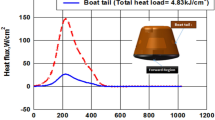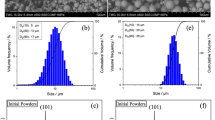Abstract
Indian Space Research Organisation, India has successfully flight tested the reusable launch vehicle through launching of a demonstration flight known as RLV-TD HEX mission. This mission has given a platform for exposing the thermal protection system to the real hypersonic flight thermal conditions and thereby validated the design. In this vehicle, the nose cap region is thermally protected by carbon–carbon followed by silica tiles with a gap in between them for thermal expansion. The gap is filled with silica fibre. Base material on which the C–C is placed is made of molybdenum. Silica tile with strain isolation pad is bonded to aluminium structure. These interfaces with a variety of materials are characterised with different coefficients of thermal expansion joined together. In order to evaluate and qualify this joint, model tests were carried out in Plasma Wind Tunnel facility under the simultaneous simulation of heat flux and shear levels as expected in flight. The thermal and flow parameters around the model are determined and made available for the thermal analysis using in-house CFD code. Two tests were carried out. The measured temperatures at different locations were benign in both these tests and the SiC coating on C–C and the interface were also intact. These tests essentially qualified the joint interface between C–C and molybdenum bracket and C–C to silica tile interface of RLV-TD.




















Similar content being viewed by others
References
A. Schettino, S. Borrelli, Applicability of SCIROCCO Plasma Wind Tunnel for Testing the Thermal Protection System of FESTIP Concept Vehicles. AIAA-98-1509
S.H. Laure, M. Auweter-Kurtz, Experimental Simulation of the Stagnation Point Flow Field of an Aerobraking High Velocity Reentry Vehicle Within a Plasma Wind Tunnel. AIAA 94-2569
M. Auweter-Kurtz, H.L. Kurtz, S. Lauret, Plasma generators for re-entry simulation. J. Propuls. Power 12, 1053–1061 (1996)
A. Pillai, et al., Thermal Performance Evaluation of Carbon Phenolic Tiles in the Fore Body Region of HSP Crew Module Using Plasma Wind Tunnel Facility. IHMTC 2015-1412
M. Ajith, A. Pillai, et al., Non-equilibrium Flow Simulation of Plasma Wind Tunnel Test of HSP Crew Module. IHMTC 2015-595
Author information
Authors and Affiliations
Corresponding author
Rights and permissions
About this article
Cite this article
Pillai, A., Krishnaraj, K., Sreenivas, N. et al. Performance Evaluation of Nose Cap to Silica Tile Joint of RLV-TD under the Simulated Flight Environment using Plasma Wind Tunnel Facility. J. Inst. Eng. India Ser. C 98, 731–739 (2017). https://doi.org/10.1007/s40032-017-0402-x
Received:
Accepted:
Published:
Issue Date:
DOI: https://doi.org/10.1007/s40032-017-0402-x




